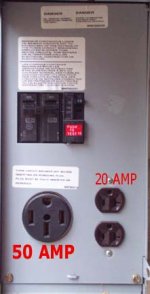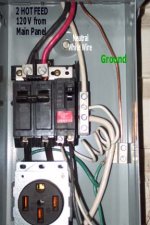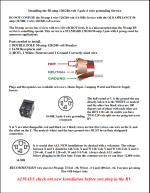http://rvservices.koa.com/rvinformation/rvmaintenance/rv-electrical-101.asp said:
RV Electrical 101 - Dennis Gaub
If you own a recreational vehicle that has a 50-amp electrical system and you've pulled into a campground where both 50- and 30-amp service are available, please pick the 50-amp service.
That request accompanies advice from an expert on RV systems, Jim Finch, KOA's assistant vice-president/technical services.
Hooking up a 50-amp vehicle to a 50-amp power pedestal whenever possible will help protect the long-term dependability of appliances in your rig, Finch says. Plus, making the 50-50 match will show consideration for fellow campers, allowing them to get an adequate electrical supply, and boost the reliability of the campground's power system.
"If they've got it (50-amp service), use it," he says.
Sometimes, however, the owner of a 50-amp RV will have to use 30-amp service because that's the only power available at a campground. When that happens, Finch advises trying to "to be good to (the campground) and to yourself, and take it easy on what you use because (with heavy demand) you pull down your own rig and every other rig on that circuit. And, you overload the campground's electrical design.
"So, if you're not plugged into a 50-amp (circuit), you need to realize you can't use everything," he says.
Campers might think that a campground's breakers will fully protect RVs against an electrical overload. But don't count on that, Finch warns.
He explained why:
The breakers for the electrical systems in most campgrounds are designed with a tolerance of 20-percent, plus or minus. (If breakers tripped at exactly 30 amps, they would cost much more perhaps 10 times as much as breakers normally used.)
A 30-amp outlet supplies 3,600 watts (30 amps multiplied by 120 volts).
Therefore, the breaker on that outlet could meet code and still trip anywhere between a total load of 2,880 watts (80 percent of 3,600 watts) and 4,320 watts (120 percent of 3,600 watts).
That generally isn't a problem for 30-amp rigs, which normally have appliances with total power demand well within the limits of breakers on campground outlets, Finch says.
But, it's different when owners of 50-amp rigs hook up to 30-amp outlets, then run a whole bevy of appliances, including power-hungry equipment such as heaters and air conditioners.
That sets up a situation where the breaker on a 30-amp outlet may not trip until the load exceeds 4,000 watts. And, Finch explains, "that's why you'll go into an RV park and a 30-amp plug will be burned up because it isn't designed to carry that kind of wattage."
Campers sometimes misunderstand the relationship between amps and total wattage, according to Finch, and that potentially harms both their rigs and the profitability that campgrounds need to continue operation.
They may think there's a proportionate link between differing amp levels when, in fact, that isn't necessarily so. For example, 20-amp service requires 2,400 watts (20 amps times 120 watts), and 30-amp service needs 1-1/2 times as much power (3,600 watts, or 30 amps times 120 watts). For 50-amp service, however, the potential amount of power used 12,000 watts, or 50 amps times 240 volts represents more than three times as much possible demand as 30-amp service.
Conversely, a 50-amp rig hooked up to a 30-amp outlet is only getting about one-third of the power that the rig may need to run a full complement of appliances.
Finch says it's helpful to think of home wiring, which is designed with the assumption that not all outlets will be in use at the same time, nor will high-voltage appliances be plugged into all sockets simultaneously. The same principle applies to the design of electrical circuits in commercial buildings and campgrounds. And an overload causes the same result in every case a tripped breaker and, possibly, a burned-out plugin.
It complicates matters when a 50-amp rig plugs into 30-amp service designed for perhaps 10-15 units because it's as if three RVs have just joined the circuit, he says.
Ultimately, Finch asks owners of 50-amp rigs to consider the economics. They may be saving a few dollars per night by plugging into 30-amp service. But the continued strain on an air conditioner or microwave, especially when either struggles to start running on substandard power, might end up damaging the appliance. And that could bring a costly bill -- $1,000 or more to repair or replace the unit.


